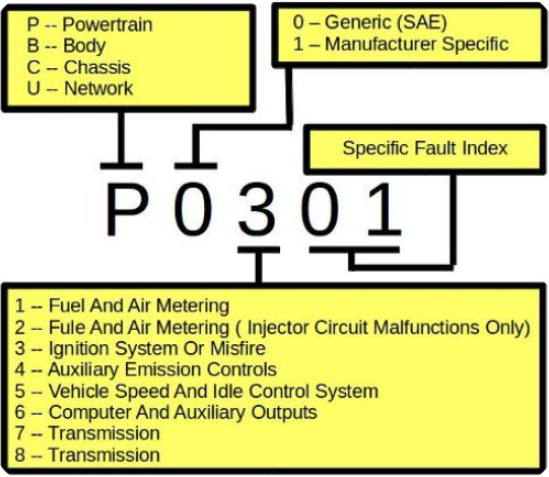Here you have a list of some common generic OBD-II codes. You can also check what they mean in terms of repair and drivability. There are many other codes; this is just an example of what you can find. The costs of repairing and maintaining a vehicle keep going up but saving money in a Direct auto insurance way is something you can control.

What Common OBD-II Codes Mean
P0171 through P0176 – Oxygen Sensors reporting a rich or lean condition
What it means: The O2 sensors in your exhaust tell the computer that there’s either too much or too little air or fuel flowing through your engine.
What is broken: This is one of those ancillary codes that trigger when any of a number of things goes wrong with your engine. So, it could be anything from a vacuum leak to a bad fuel injector to a blown head gasket. But it will also happen when the O2 sensor itself malfunctions. The latter is more likely the case if you get other codes indicating an O2 sensor circuit or O2 heater circuit malfunction.
Can I drive it: Probably yes, but use caution? If the computer detects any accompanying O2 sensor fault codes, it will ignore the O2 sensor and go into open-loop operation. But oftentimes, a rich/lean reading will indicate any of the above conditions, as well as ignition system faults. A worn condition will fry your engine, and a rich condition will cost you fuel mileage and power, so drive as little as possible before getting this checked out.
P0300 and P0301 through P308 – Random Cylinder Misfire, Misfire at a Cylinder
What it means: With a random misfire, something is going wrong in your engine that is causing more than one cylinder not to work. With a single-cylinder misfire, something is keeping a single-cylinder from working.
What is broken: Like the O2 sensor rich/lean code, this one almost by definition accompanies other faults. Some of them will throw codes of their own, and some will not. A random misfire – P0300 – indicates a system-wide problem like low fuel or intermittent fuel pressure, or a bad sensor or two. A single-cylinder misfire could mean a problem with an ignition coil (if you have got coil-on-plug ignition), a bad spark plug, or a malfunctioning fuel injector. It could also indicate more serious mechanical problems with the pistons, valves, or gaskets.
Can I drive it: Not a good idea until you find out what is causing the misfire? And even after that, it is still not a particularly good idea, since consistent misfire can cause problems with the engine. Raw fuel flowing through the engine can also damage your catalytic converter, so it is best to fix the problem before taking that road trip to Malibu.
P0325 through P0334 – Knock sensor range and circuit malfunction
What it means: The knock sensor, which “listens” to the sound of combustion in your engine, is either reporting abnormal combustion – codes P0326 and P0331 – or is itself not functioning correctly.
What is broke: A knock sensor works something like a microphone, converting vibrations in the engine to electrical impulses that the computer can read. Normally, the engine would send a steady series of pulses, but misfire and knock or ping in the engine will trigger the knock sensors and tell the computer that something is wrong.
Can I drive it: Not until you find out what is up with your engine? Knock sensor triggering can indicate serious problems if its legit and not a result of knock sensor malfunction. At the very least, it can indicate that you are using a fuel with too low an octane rating. At worst, the knock sensor could be telling you that your engine is on the verge of self-destruction.
P0420 through P0434 – Catalyst System Efficiency Below Threshold
What it means: The catalytic converter is not working
What is broke: This reading comes from the second oxygen sensor, the one after the catalytic converter, and indicates that the converter is not converting properly. This could happen for a few reasons: physical damage to the catalytic converter matrix, “poisoning” of the wash coat with materials like lead and phosphorus, and failure of the converter to reach its 400-plus degree operating temperature.
Can I drive it: Mankind was well capable of operating engine vehicles 80 years before catalytic converters, and your car will continue to run as long as the converter internals has not collapsed and blocked exhaust flow out of the converter. That is the theory, anyway. Converter failure will cause your computer to go into “limp-home mode,” which can do anything from de-tune engine power to stick the car in second gear, depending upon the programming. Limp-home mode’s primary purpose is to make the car practically undrivable until you fix the converter.
Compare online quotes from Young America Insurance Company, and save on the coverage you need today. If you choose a $20 car insurance plan, go for higher limits along with a bigger deductible amount.
